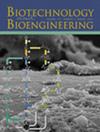本质荧光纳米级肽聚集体精氨酸到瓜氨酸交换。
IF 3.6
2区 生物学
Q2 BIOTECHNOLOGY & APPLIED MICROBIOLOGY
引用次数: 0
摘要
短肽的超分子组装成有序结构为开发生物纳米材料提供了希望,这些材料在药物输送、电子和光学工程中具有多种应用。多肽聚集体的固有荧光通常与致密氢键网络中电子密度的离域、芳香氨基酸残基的偶极偶联以及与超分子结构相关的“团簇衍生发光”有关。在少数例子中,短肽的自组装提供了有序的内在荧光纳米结构。在这项研究中,用大环肽中的瓜氨酸取代单个精氨酸残基导致了内在荧光。母体含精氨酸肽大环先前被证明采用β-片状构象,聚集成非荧光球形颗粒。从胍侧链的静电正电荷到氢键中性尿素的变化导致β-片肽通过π-π堆叠相互作用的电子离域现象聚集成更大尺寸的本质荧光棒。本文章由计算机程序翻译,如有差异,请以英文原文为准。
Intrinsically Fluorescent Nano-Scaled Peptide Aggregates Upon Arginine to Citrulline Swap.
The supramolecular assembly of short peptides into ordered structures offers promise for developing bio-nanomaterials with diverse applications in drug delivery, electronics, and optical engineering. Intrinsic fluorescence of polypeptide aggregates is typically associated with delocalization of electron densities in dense hydrogen bonding networks, dipolar coupling of aromatic amino acid residues, and possibly by the 'cluster-derived luminescence' associated with supramolecular structures. In a handful of examples, self-assembly of short peptides has provided ordered intrinsically fluorescent nanostructures. In this study, replacement of a single arginine residue with citrulline in a macrocyclic peptide has led to intrinsic fluorescence. The parent arginine-containing peptide macrocycle was previously shown to adopt a β-sheet conformation that aggregated into nonfluorescent spherical particles. The change from the electrostatic positive charge of the guanidine side chain to a hydrogen bonding neutral urea caused the β-sheet peptide to aggregate into larger-sized intrinsically fluorescent rods by a phenomenon that is ascribed to electron delocalization through π-π stacking interactions.
求助全文
通过发布文献求助,成功后即可免费获取论文全文。
去求助
来源期刊

Biotechnology and Bioengineering
工程技术-生物工程与应用微生物
CiteScore
7.90
自引率
5.30%
发文量
280
审稿时长
2.1 months
期刊介绍:
Biotechnology & Bioengineering publishes Perspectives, Articles, Reviews, Mini-Reviews, and Communications to the Editor that embrace all aspects of biotechnology. These include:
-Enzyme systems and their applications, including enzyme reactors, purification, and applied aspects of protein engineering
-Animal-cell biotechnology, including media development
-Applied aspects of cellular physiology, metabolism, and energetics
-Biocatalysis and applied enzymology, including enzyme reactors, protein engineering, and nanobiotechnology
-Biothermodynamics
-Biofuels, including biomass and renewable resource engineering
-Biomaterials, including delivery systems and materials for tissue engineering
-Bioprocess engineering, including kinetics and modeling of biological systems, transport phenomena in bioreactors, bioreactor design, monitoring, and control
-Biosensors and instrumentation
-Computational and systems biology, including bioinformatics and genomic/proteomic studies
-Environmental biotechnology, including biofilms, algal systems, and bioremediation
-Metabolic and cellular engineering
-Plant-cell biotechnology
-Spectroscopic and other analytical techniques for biotechnological applications
-Synthetic biology
-Tissue engineering, stem-cell bioengineering, regenerative medicine, gene therapy and delivery systems
The editors will consider papers for publication based on novelty, their immediate or future impact on biotechnological processes, and their contribution to the advancement of biochemical engineering science. Submission of papers dealing with routine aspects of bioprocessing, description of established equipment, and routine applications of established methodologies (e.g., control strategies, modeling, experimental methods) is discouraged. Theoretical papers will be judged based on the novelty of the approach and their potential impact, or on their novel capability to predict and elucidate experimental observations.
 求助内容:
求助内容: 应助结果提醒方式:
应助结果提醒方式:


